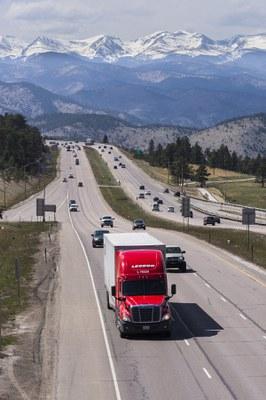Strategic Planning
Our Strategy
Anything that is grown, mined or made must be moved. From your favorite Colorado craft beer, to Olathe Sweet Corn and Rocky Ford cantaloupes in grocery stores, to the Gypsum board drywall used to construct your home, to the Amazon Prime package you just ordered online – moving products and packages by truck, rail and air is an ever-present part of our lives that is often taken for granted.
Colorado’s residents, visitors and businesses rely on our state’s multimodal transportation systems to move products around the state and to destinations around the globe. But to keep Colorado’s economy competitive and our communities attractive, we must continue to maintain our existing freight infrastructure in good condition, while improving freight mobility through new technological approaches and innovative ideas.
This is no easy job. Colorado moves many products. According to the Federal Highway Administration's (FHWA) Freight Analysis Framework (FAF) dataset, over 420 million tons of products valued at over $341 billion was moved throughout Colorado in 2016. That amounts to nearly 75 pounds for each Coloradan, every day.
As Colorado’s population and economy grows, so will demand for moving packages and products throughout the state. Planes, trains and trucks operate at airports, on railroad tracks, over state highways, and through a variety of facilities that link these modes together. Together, these transportation modes combined with the infrastructure they run on are Colorado’s multimodal freight systems. These systems deliver products, supply businesses, create jobs, and support communities across Colorado.

Annual Production of Colorado Agricultural Products
2.6 Million
head of cattle
13,000
beef producers
417.8 Million
gallons of milk
#1 Global
mozzarella producer
147.46 Million
bushels of corn
68 Million
pounds of sweet corn
89.8 Million
bushels of wheat
$535.8 Million
in global exports
63.3 Million
pounds of sunflowers
6,000 Gallons
of sunflower oil daily
1.45 Trillion
eggs annually
5.89 Million
chickens
Planning ahead enables CDOT to determine what is important, where to start, and what steps are necessary to achieve our strategic goals.
Ensuring the continued movement of products, packages, supplies and inventories is critical to keep Colorado’s economy moving. Yet, the freight transportation issues and needs of Colorado’s industries and residents are constantly evolving in response to global forces, national trends, and local opportunities. CDOT, together with planning partners and stakeholders, is continually looking ahead and planning to meet our future needs.
How do we make major investment decisions when project needs far outweigh available resources? How do we prioritize between adding truck passing lanes on a mountain roadway, improving a road to a new facility, developing safe truck parking areas, or adding new truck runaway ramps?
- Step 1: Gather Information
The freight branch uses real-world insight to identify opportunities and solutions to transportation issues and influence policy decisions. Sourcing and analyzing various data provides insight into freight-related opportunities and challenges. In addition, the Freight Advisory Council provides essential perspectives from public and private sector partners to understand what and how they are experiencing Colorado’s freight network. A recent example of understanding specific needs includes the Truck Parking Assessment (available upon request).
- Step 2: Define Goals
Strategic Goals are established and outlined in the Colorado Freight Plan, approved as a IIJA compliant plan in March 2024, and the 2024 Colorado Freight and Passenger Rail Plan, adopted by the Transportation Commission in February 2024.
Freight Goals include:
- Enhance safety and security for commercial carriers
- Improve mobility and efficiency of goods movement
- Maintain the system
- Improve economic vitality and industry competitiveness
- Improve sustainability and reduce environmental impacts
- Step 3: Establish a Plan
CDOT plans ahead to create the best system possible within the resources allocated. The Colorado Freight Plan highlights Colorado’s freight opportunities, challenges and solutions that have been evaluated and informed by freight stakeholders. This includes a road map to deploy the strategic goals through practices and define the outcomes we expect to reach long-term.
- Step 4: Make Decisions
Everyday freight plan and project decisions are made through a continuous, comprehensive, and collaborative process, while being consistent with federal and state requirements. Like setting a household budget, CDOT prioritizes projects that meet the strategic goals and provides the greatest benefits at the lowest costs. The Colorado Freight Plan guides CDOT’s decisions related to prioritizing freight project investment, state policies, and implementation of strategies to address key issues and needs.
Here's an example: Our approach to the Truck Parking gaps in our state (available upon request)